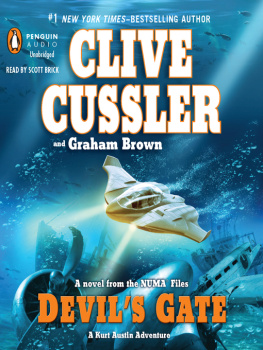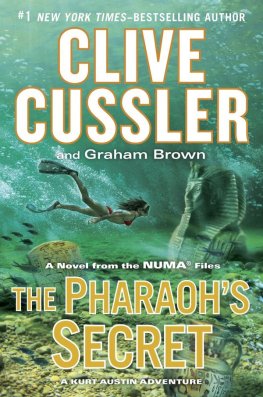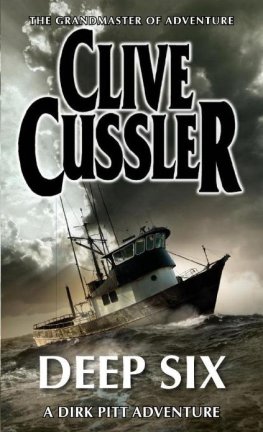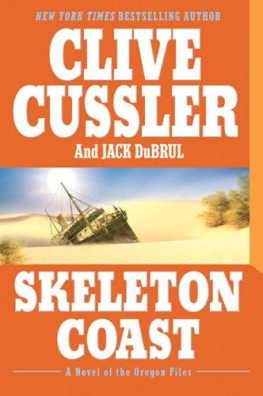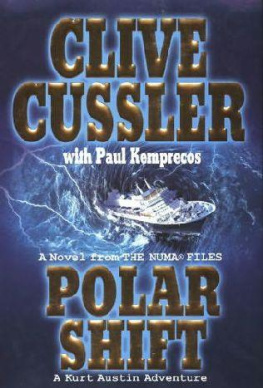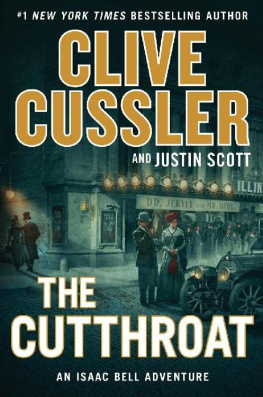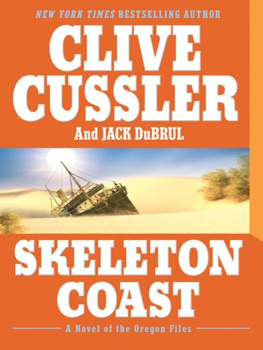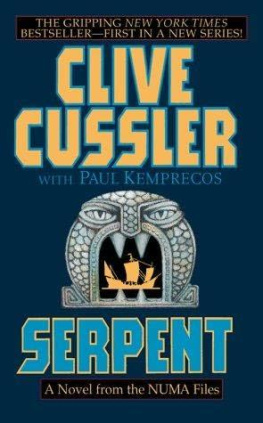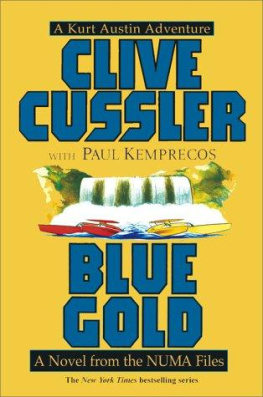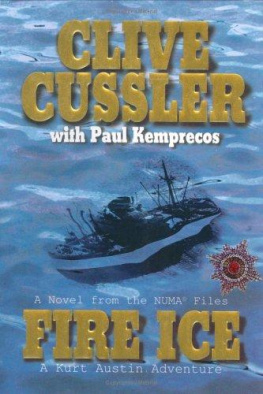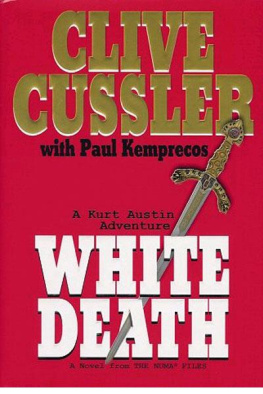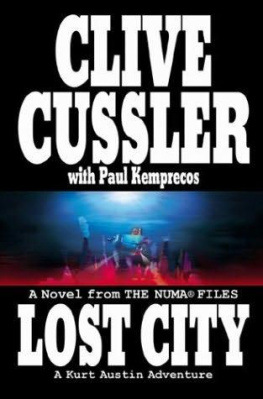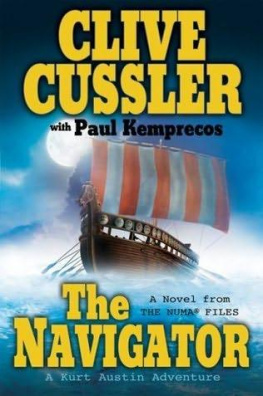Clive Cussler's Serpent
INTRODUCING A FRIEND
When I was asked to introduce Kurt Austin, Joe Zavala, and their friends who serve the National Underwater and Marine Agency, I accepted with great pleasure and enthusiasm. I've had the privilege of knowing Kurt and Joe for many years. We first met when they joined NUMA at Admiral Sandecker's invitation not long after Al Giordino and I came on board. Although we've never had the opportunity to work on the same project together, Kurt and Joe's escapades above and underwater have often fired my imagination and left me wishing I'd done that.
In some ways Kurt and I are similar. He's a few years younger, and we hardly look alike, but he lives in an old remodeled boathouse on the Potomac River and collects antique dueling pistols, a wise choice when you consider how much simpler they are to maintain and store than the old. cars in my aircraft hangar. He's also into rowing and sailing, which sends me into exhaustion just thinking about it.
Kurt is resourceful and shrewd, and he has more guts than a white shark on steroids. He's also a genuine nice guy with two tons of integrity who believes in the flag, mothers, and apple pie. To my chagrin, the ladies find him very attractive, even more attractive than they find me.
The only obscure conclusion I can reachit pains me deeply to say sois that between the two of us he's better looking.
I'm happy that Kurt and Joe's exploits are finally being chronicled from the NUMA Files. There is not the slightest doubt that you will find them entertaining as well as an intriguing way to while away the time. I know that I have.
Dirk Pitt
ACKNOWLEDGMENTS
WITH APPRECIATION TO DON STEVENS for taking us down to the Andrea Doria without getting our feet wet, and for the work of two fine writers, Alvin Moscow and William Hoffer, whose books Collision Course and Saved so vividly describe the human side of that great sea tragedy. And for the tenacity of that intrepid explorer John L. Stephens, who braved mosquitoes and malaria as he trekked through the Yucatan discovering the wonders of the lost Mayan civilization.
PROLOGUE
July 25, 1956
South of Nantucket Island
SO QUICKLY DID THE PALE SHIP appear, she seemed to spring whole from the depths, gliding like a ghost across the silver pool of luminescence cast by the near full moon. Tiaras of porthole lights glittered along her bone-white sides as she raced eastward in the warm night, her sharply raked bow knifing through the flat seas as easily as a stiletto cutting through black satin.
High in the darkened bridge of the Swedish American liner Stockholm, seven hours and 130 miles east of New York City Second Mate Gunnar Nillson scanned the moonlit ocean. The big rectangular windows that wrapped around the wheelhouse gave him a panoramic view as far as he could see. The surface was calm except for a ragged swell here and there. The temperature was in the seventies, a pleasant change from the heavy humid air that weighed over the Stockholm that morning as the liner left its berth at the Fifty Seventh Street pier and headed down the Hudson River. Remains of the woolly overcast drifted in tattered shrouds across the porcelain moon. Visibility was a half dozen miles to starboard.
Nillson swept his eyes to port, where the thin, dark horizon line became lost behind a hazy murkiness that veiled the stars and welded the sky and sea.
For a moment he was lost in the drama of the scene, sobered by the thought of the vast and trackless emptiness yet to be crossed. It was a common feeling among mariners, and it would have lasted longer if not for the tingling in the soles of his feet. The power produced by the massive twin 14,600horsepower diesels seemed to flow up from the engine room through the vibrating deck and into his body, which swayed almost imperceptibly to adjust for the slight roll. Dread and wonder ebbed, to be replaced by the omnipotent sensation that comes with being in command of a swift liner racing across the ocean at top speed.
At 525 feet sterntostern and 69 feet in the beam, the Stockholm was the smallest liner in the transatlantic trade. Yet she was a special ship, sleek as a yacht, with racy lines that swept back from her long forecastle to a stern as softly rounded as a wine glass. Her gleaming skin was all white except for a single yellow funnel. Nillson luxuriated in the power of command. With a snap of his fingers the three crewmen on watch would jump to his orders. With a flick of a lever on the ship's telegraphs he could set bells clanging and men scurrying to action.
He chuckled, recognizing his hubris for what it was. His four-hour watch was essentially a series of routine tasks aimed at keeping the ship on an imaginary line that would bring it to an imaginary point near the stubby red lightship that guarded Nantucket's treacherous shoals. There the Stockholm would make the northeasterly turn onto a course that would take its 534 passengers past Sable Island on a straight shot across the Atlantic to the north of Scotland and, finally Copenhagen Harbor.
Even though he was only twenty eight and had joined the Stockholm barely three months earlier, Nillson had been on boats since he could walk. As a teenager he'd worked the Baltic Sea herring bats and later served as an apprentice seaman with a huge shipping company. Then came the Swedish Nautical College and a stint in the Swedish navy. The Stockholm was one more step in achieving his dream, to be master of his own ship.
Nillson was an exception to the common tall blond Scandinavian stereotype. There was more of Venice than Viking in him. He had inherited his mother's Italian genes, along with her chestnut hair, olive skin, smallboned stature, and sunny temperament. Darkhaired Swedes were not unusual. At times Nillson wondered if the Mediterranean warmth lurking in his large brown eyes had anything to do with his captain's frostiness. More likely it was a combination of Scandinavian reserve and the rigid Swedish maritime tradition of strict discipline: Nevertheless, Nillson worked harder than he had to. He didn't want to give the captain a single reason to find fault. Even on this peaceful night, with no traffic,. near flat seas, and perfect weather, Nillson paced from one wing of the bridge to the other as if the ship were in the teeth of a hurricane.
The Stockholm's bridge was divided into two spaces, the twentyfootwide wheelhouse in front and the separate chartroom behind it. The doors leading out to the wings were left open to the light southwest breeze. At each side of the bridge was an RCA radar set and a ship's telegraph. At the center of the wheelhouse the helmsman stood on a wooden platform a few inches off the polished deck, his back to the dividing wall, hands gripping the steering wheel, eyes on the face of a gyrocompass to his left. Directly in front of the helm, below the center window, was a course box. The three wooden blocks in the box were printed with numbers to keep the helmsman's mind focused on the heading.
The blocks were set at 090.
Nillson had come up a few minutes before his eightthirty watch to look at the weather reports. Fog was forecast for the area hear the Nantucket lightship. No surprise there. The warm waters of the Nantucket shoals were a virtual fog factory. The officer going off duty told him the Stockholm was just north of the course set by the captain. How far north he couldn't tell. The radio positioning beacons were too far away to get a fix.
Nillson smiled. No surprise here, either. The captain always took the same course, twenty miles north of the eastbound sealane recommended by international agreement. The route wasn't mandatory, and the captain preferred the more northerly track because it saved time and fuel.
Scandinavian captains did not do bridge watch, customarily leaving the ship in charge of a single officer. Nillson quickly settled into a series of tasks. Pace the bridge. Check the righthand radar. Glance at the engine telegraphs on each wing of the bridge to make sure they were set Full Speed Ahead. Scan the sea from a wing. Make sure the two white masthead navigation lights were on. Stroll back into the wheelhouse. Study the gyrocompass. Keep the helmsman on his toes. Pace some more.
Next page

